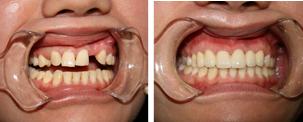Why is there such a big price difference for porcelain teeth in different places?
Why is there such a big difference in the price of porcelain teeth? The experts from the Department of Stomatology at the PLA 454 Hospital in Nanjing revealed the "secrets" behind it.
Cost-saving method: reducing materials
"Everyone says that gold-ceramic porcelain teeth are good, so why do some clinics only charge 900 yuan per tooth?" the reporter asked directly. The doctor explained that for example, making one molar requires 2.5 grams of gold, which costs 687.5 yuan; imported ceramic powder costs 15.6 yuan; sandblasting, wax, hard plaster, etc., cost 60 yuan; plus other materials, the material cost of a porcelain tooth generally reaches around 50%. This does not include labor, water, electricity, rent, equipment wear and tear, and other costs.
However, some unscrupulous clinics have their ways to save money on materials. "Some individual clinics often buy scraps at low prices," said a technician while holding up an alloy that had been fired. He explained that this material, which has been repeatedly melted, lacks sufficient components and even undergoes quality changes, making it incapable of withstanding pressure, bending, or corrosion. It also doesn't bond well with ceramics. Teeth made from this material will fall out or chip within days of being installed. "The gold used in cheap porcelain teeth also lacks sufficient purity," the doctor added. The center uses gold with a content of 88.7%, while some clinics use gold with a content of only 10-15%, or even copper as a substitute. As for ceramic powder and adhesives, small clinics often use inferior materials to pass off as quality ones.
Cost-saving method: cutting corners
Outpatient examination, consultation, taking dental impressions, intraoral design, material selection, model confirmation... Making one porcelain tooth involves seven or eight procedures in the outpatient part alone. In the production part, it's even more complicated: casting molds, making wax patterns, high-temperature electric firing, masking, applying ceramics, quality inspection... There are over forty steps involved. "Even with assembly-line production, it takes five days to make one tooth," the doctor said. In some small clinics, teeth can be fitted three days after extraction, and one tooth can be completed in a week, clearly cutting many corners in the process.
Vacuum mixer, high-temperature electric kiln, high-frequency centrifugal casting machine, pen-type sandblaster, ultrasonic oscillation washer, laser spot welder... In the over forty production steps, each porcelain tooth goes through dozens of hands and is processed by over a dozen specialized machines. Many steps have strict requirements for indoor temperature, humidity, dust prevention, hygiene, etc.
Cost-saving method: labor force
Abandoned factories become processing workshops, hiring people at low prices, those who have worked in insurance or as machinists can all start making porcelain teeth without focusing on quality. Some clinics save a large sum of money on manpower. A dentist from the Department of Stomatology at the PLA 454 Hospital in Nanjing introduced that now a qualified technician must be a bachelor's or vocational school graduate in oral restoration technology, and must have years of rich experience in making teeth to master the skills.
To learn more, you can consult online with a doctor or call the hotline: 4000-454-678
Online website of this department: http://www.101kq.com/




